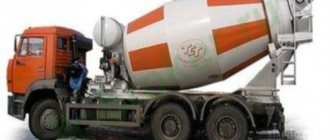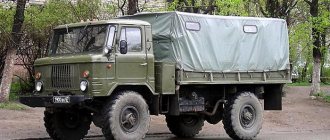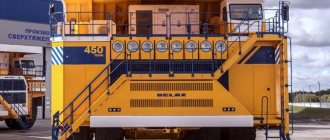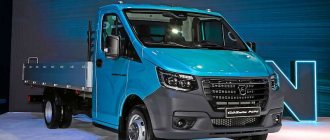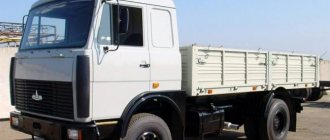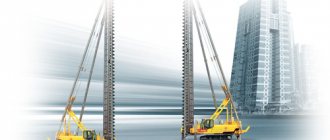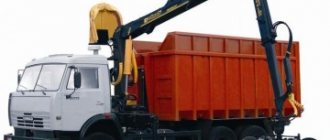Beton-House.com
Website about concrete: construction, characteristics, design. We combine the experience of professionals and private craftsmen in one place
The designs of concrete mixer trucks are different, but the end result is the same
The general design of a concrete mixer truck can differ radically from each other. Have different technical characteristics, parameters by which they are qualified. The main task remains common - delivering concrete to construction sites, sometimes significantly distant from concrete plants.
The construction of houses and cottages in agricultural areas, road repairs and new construction of highways require large “infusions of concrete”. Installations and structures that transport concrete in accordance with the strict GOST rules must meet certain criteria.
- Caring owner of equipment
Classification criteria for concrete mixer trucks
From the GOST requirements for delivering concrete to its destination, the following can be identified as fundamental: to exclude the penetration of precipitation into the concrete mixture: it must remain homogeneous (homogeneous), direct sunlight does not touch the surface of the solution, minimal losses during loading, transportation, unloading.
Automobile concrete mixer on the diagram
And one more diagram.
Mixer MXR1350B, concrete mixer volume 7 m³, based on KamAZ-4310 chassis
Car modification
Installing a concrete mixing plant on a car and giving it new functions and properties was forced by life at the beginning of the 20th century, when construction grew into an industry. Delivering freshly mixed concrete in an open, metal car body was no easy feat.
Cities, dams, factories were built, and a lot of building materials were required, including concrete. It splashed over the edge on potholes in the roads, got wet in the rain, froze in frosts, and dried out under the scorching rays of the sun without protection. The first experiments in delivering concrete mortar in special barrels mounted on a car took place in the mid-30s.
| Magic transformations of concrete mixer trucks | Periods of development |
| The first-born of serial concrete mixer trucks in the USSR | After 2 years of preparatory work, the Kiev plant in 1938 launched serial production of concrete mixer delivery trucks. The concrete mixer looks like an “ugly duckling” and a little ridiculous from the height of the past years, but then it made it possible to have a mixing drum of 1.5 m³, a small water tank (240 + 40 l), which was enough to prepare a concrete solution and wash the drum. This design was based on the chassis of the ZIS-6, YAG-6. Their disadvantages outweighed their advantages, but they lasted until the post-war period. |
| Pear-shaped drum set at 17º to the horizon | The technical characteristics of concrete mixer trucks were improved after the war. The volume of the concrete mixer became 1.6 m³, the water tank was 270+80 l. The big inconvenience of this design was that the car had a diesel engine, and the drive had a gasoline engine. But it was a more advanced design based on the YaAZ-200, which served well until the 60s. |
| In the photo on the left is SB-92 with an increased speed of unloading concrete, on the right is SB-92V-1 based on KamAZ | The rate of unloading of concrete solution was increased by reducing the angle of inclination of the drum axis from 18º to 15º. Automobile concrete mixers based on KamAZ met the needs of domestic builders and were supplied to China, Hungary, Vietnam, Bulgaria, etc. |
| A symbiosis of joint development - a concrete mixer truck and Kamensky fur. plant | Construction sites around the world use cost-effective, durable, reliable devices that can operate in harsh conditions. The licensed production of German equipment at Soviet mechanical factories did not fully meet the needs of domestic builders. If 1000 sets were produced for the foreign market, then 200 for the domestic market. |
If in the 70s there was a shortage of this equipment because only 2 mechanical factories in the USSR were producing, then by the end of the 20th century, the auto concrete mixer organically fit into the production processes of modern construction.
Attention: Equipment for obtaining and transporting concrete mortar can be mounted on a truck chassis of the appropriate load capacity. In Russia, the most common concrete mixers are KamAZ 6520.
Automotive giants such as Ural, MAZ, KrAZ and KamAZ produce chassis for concrete installations. Foreign partners have always represented serious competition to domestic automakers, so there is no shortage of these installations now.
Types of modifications
Having heard the simple phrase 90 x 60 x 90, every adult understands that we are talking about the parameters of a beautiful female figure. Concrete mixer trucks have their own technical characteristics.
Manufacturers of these structures strive to improve them, so there are various modifications in the design of concrete mixers, and the criteria by which they are qualified:
- Type of working engine.
Installs independently.
Automatic concrete mixer: barrel volume 10 m³ with autonomous engine
- The machine was manufactured at the Pushkin Mechanical Repair Plant. Basic chassis from Hyundai HD 370, licensed by SCHWING – STETTER.
KamAZ 6501 chassis, concrete mixer 58148Y
- The drum capacity is 9 m³, these designs accumulate modern technological innovations in this area;
- A concrete mixer car with an autonomous engine continues to work if the car fails. This indicator characterizes the concrete mixer as a reliable installation, but the car itself has an impressive weight.
Installed on the chassis. The engine on the chassis has a low noise level and is lighter in weight. Concrete mixers, however, look somewhat unusual.
On TIGARBO with an engine on a chassis, something seems to be missing
Rear view of the cabin.
Engines on the chassis are highly economical and environmentally friendly
- A concrete mixer truck equipped with an engine on a chassis uses fuel economically and emits less harmful substances into the atmosphere.
- Drum drive type
VOLVO FM concrete mixer truck with mechanical pump drive
The drive of the mixing drum was previously mechanical, but there are fewer and fewer such machines left.
Mixer for preparing solution with hydraulic drive
- The hydraulic drive, which has a smooth ride and a more advanced design, squeezes out mechanics and rightfully occupies its niche.
- Unloading method
- The first unloading method is the most common. It allows you to approach the unloading object as close as possible and deliver the solution more accurately.
- The second “forward” unloading method is attractive because the driver controls the process from the cab.
- One of the main characteristics of the machine is the size of the mixing drum. The capacity ranges from the smallest of 2 m³ to the largest of 12 m³. The installation price changes accordingly, which is influenced by the cost of the chassis and the manufacturer.
Types of concrete mixers
Depending on the type of work performed, technical operating conditions and volumes, mixers are selected according to the appropriate parameters. All types of concrete mixer trucks differ according to such technical characteristics as equipment capacity, power, loading and unloading method.
Machine classification
1. According to the design features of unloading:
- with front unloading
— the advantage of this type is that the driver does not need to get out of the car to carry out the process of unloading the solution;
- with rear unloading
— there are some inconveniences for the driver compared to the first method, but this method is most widely used in the CIS countries.
2. By type of drum drive:
- hydraulic (modern);
- mechanical (outdated machines).
3. By type of motors used in mixing plants:
- autonomous
- are considered reliable, since the engine will continue to operate even if the vehicle’s drive stops working for technical reasons;
- on chassis
— lighter than autonomous ones, quieter, environmentally friendly.
Machine characteristics
Main indicators characterizing concrete mixer trucks:
- maximum permissible volume of mixture;
- maximum weight of the solution, including a filled water tank;
- weight of the concrete mixer truck with all equipment, including water tank.
Modern automixers are available with drum volumes from 4 to 12 cubic meters. m with a water tank volume of up to 800 l. There are also more spacious models, but they are made to order. The useful volume of such machines reaches 15 cubic meters. m.
The following components are offered to the buyer of automixers:
- various hydraulic transmissions;
- water tanks of the required volume;
- mixing drums;
- modernized control systems;
- improved engines.
All equipment can be installed, at the customer’s request, on both domestic and imported chassis.
How to reduce concrete work time
Late delivery of concrete solution, partial short deliveries or, on the contrary, excess of it, who is not irritated by these “inconsistencies”.
Special equipment for concrete delivery
In order to correctly calculate the needs for the required amount of concrete mixture, to properly prepare the unloading of the solution, you need to have a basic understanding of the design of special equipment, which includes truck-mounted concrete mixers, automixers, ABS and many other types of construction equipment.
Mixer filling for constant mixing of concrete mixture
- In the first option, the components, dry components from which concrete is made, are loaded directly at the plant, filled with water and slowly sent to the site. During the journey, the mixture is mixed until ready and maintained in the desired consistency, convenient for unloading;
- In the second case, the concrete mixer truck is loaded with ready-made mortar. The concrete mixer delivers liquid concrete to the transportation site;
Attention: Keeping the concrete mixture in a homogeneous state is ensured by constant mixing. This is a mandatory condition for transportation.
- The photo clearly shows the spiral blades inside the mixing drum;
- The Archimedes screw works flawlessly in this design. It rotates in one direction and a concrete mass is obtained; if you turn the blades in the opposite direction, you can take ready-made concrete;
- Receiving the concrete mixture from the concrete mixer truck under pressure allows it to flow down the tray directly to the work site;
- When it is not possible for a machine to drive close to the work site, workers extend chutes to concrete mixer trucks or use special devices in the form of booms and hoses. The simplest DIY device for draining concrete is a wooden gutter.
- Ordering a special ABS, which allows you to conveniently accept concrete from a distance of 10 m, is possible only if such equipment is available. This must be clarified and agreed upon with the operator in advance;
- It is necessary to take care of the site for the ABS in advance so that it does not stand idle for precious time;
- The minimum dimensions of the site are 6 x 8 m, the distance to the edge of the pit is at least 8 m, the slope is no more than 5%;
Attention: There should not be a power line running near the unloading site, there should be free space for deploying the unloading device and space for flushing the ABS.
If everything is thought out and prepared at a high professional level, the pipe for the concrete mixer truck is waiting in the wings and lies aside, then the concrete work can be completed quite quickly.
